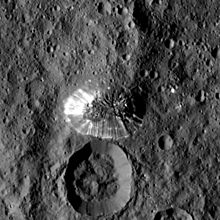Ahuna Mons
Ahuna Mons[1] je největší hora nacházející se na povrchu trpasličí planety Cerery. Hora se tyčí průměrně 4 kilometry[2] nad okolní relativně hladké pláně, maximální převýšení místy dosahuje 5 kilometrů. Na povrchu Cerery se jedná o ojedinělou takto vysokou horu. Hora má základnu o šíři přibližně 17 kilometrů. Na vrcholku se nachází řada tektonických prasklin, na svazích pak stružky a akumulovaný materiál svědčící o probíhajících svahových procesech. Na úbočí hory jsou přítomny také světlé proužky, o kterých se vědci domnívají, že jsou tvořeny směsí solí, podobně jako světlé skvrny v impaktním kráteru Occator.[3]
Předpokládá se, že celá hora vznikla jako výsledek kryovulkanismu.[4][5][6] K roku 2017 se tak jedná o ke Slunci nejbližší známý kryovulkán nalezený ve sluneční soustavě.[7]
Hora Ahuna Mons byla objevena v roce 2015 na základě snímků povrchu Cerery, který pořídila americká sonda Dawn. Nachází se přibližně na opačné polokouli než leží velký impaktní kráter Kerwan, což vedlo vědce k úvahám, že by vznik této hory mohl být spojen se seismickou energií uvolněnou během impaktu. Odhad stáří hory za pomoci počítání počtu impaktních kráterů naznačuje, že se jedná o relativně mladý útvar v řádů stovek miliónů let.[6] Ahuna Mons byla pojmenována po tradičním posklizňovém festivalu Ahuna, který slaví indické etnikum Sumi Naga.
Odkazy
Reference
- ↑ Gazetteer of Planetary Nomenclature – Ahuna Mons
- ↑ PIA20348: Ahuna Mons Seen from LAMO [online]. Jet Propulsion Lab, 7 March 2016 [cit. 2016-04-14]. Dostupné online. (anglicky)
- ↑ STONE, Maddie. Ceres' Mysterious Bright Spots Aren't Made of Ice After All. Gizmodo. October 1, 2015. Dostupné online [cit. 2016-03-25]. (anglicky)
- ↑ BURNHAM, Robert. Deep freeze puts the squeeze on dwarf planet Ceres. Arizona State University. December 15, 2015. Dostupné online [cit. 2016-03-25]. (anglicky)
- ↑ SKIBBA, R. Giant ice volcano spotted on dwarf planet Ceres. Nature. 2016-09-01. DOI:10.1038/nature.2016.20526. (anglicky)
- ↑ a b RUESCH, O.; PLATZ, T.; SCHENK, P.; MCFADDEN, L. A.; CASTILLO-ROGEZ, J. C.; QUICK, L. C.; BYRNE, S. Cryovolcanism on Ceres. Science. 2016-09-02, s. aaf4286–aaf4286. DOI:10.1126/science.aaf4286. (anglicky)
- ↑ Gale. THE MYSTERY OF AHUNA MONS, THE LONELY ICE VOLCANO. States News Service. 23 January 2017. Dostupné online [cit. 12 February 2017]. (anglicky)
Externí odkazy
 Obrázky, zvuky či videa k tématu Ahuna Mons ve Wikimedia Commons
Obrázky, zvuky či videa k tématu Ahuna Mons ve Wikimedia Commons
Média použitá na této stránce
Cropped Image
ORIGINAL IMAGE (context image): => http://photojournal.jpl.nasa.gov/jpeg/PIA19631.jpg
ORIGINAL CAPTION:
"NASA's Dawn spacecraft spotted this tall, conical mountain on Ceres from a distance of 915 miles (1,470 kilometers). The mountain, located in the southern hemisphere, stands 4 miles (6 kilometers) high. Its perimeter is sharply defined, with almost no accumulated debris at the base of the brightly streaked slope with bright streaks.
The image was taken on August 19, 2015. The resolution of the image is 450 feet (140 meters) per pixel."PIA20915: Ahuna Mons: Side View
http://photojournal.jpl.nasa.gov/catalog/PIA20915
Ceres' lonely mountain, Ahuna Mons, is seen in this simulated perspective view. The elevation has been exaggerated by a factor of two. The view was made using enhanced-color images from NASA's Dawn mission.
Images taken using blue (440 nanometers), green (750 nanometers) and infrared (960 nanometers) spectral filters were combined to create the view.
The spacecraft's framing camera took the images from Dawn's low-altitude mapping orbit, from an altitude of 240 miles (385 kilometers) in August 2016. The resolution of the component images is 120 feet (35 meters) per pixel.
Dawn's mission is managed by JPL for NASA's Science Mission Directorate in Washington. Dawn is a project of the directorate's Discovery Program, managed by NASA's Marshall Space Flight Center in Huntsville, Alabama. UCLA is responsible for overall Dawn mission science. Orbital ATK, Inc., in Dulles, Virginia, designed and built the spacecraft. The German Aerospace Center, the Max Planck Institute for Solar System Research, the Italian Space Agency and the Italian National Astrophysical Institute are international partners on the mission team. For a complete list of mission participants, see http://dawn.jpl.nasa.gov/mission.
For more information about the Dawn mission, visit http://dawn.jpl.nasa.gov.PIA20399: Dawn Color Topography of Ahuna Mons on Ceres
http://photojournal.jpl.nasa.gov/catalog/PIA20399
These color topographic views show variations in surface height around Ahuna Mons, a mysterious mountain on Ceres.
The views are colorized versions of PIA20348 and PIA20349. They represent an update to the view in PIA19976, which showed the mountain using data from an earlier, higher orbit.
Both views were made using images taken by NASA's Dawn spacecraft during its low-altitude mapping orbit, at a distance of about 240 miles (385 kilometers) from the surface. The resolution of the component images is about 120 feet (35 meters) per pixel.
Elevations span a range of about 5.5 miles (9 kilometers) from the lowest places in the region to the highest terrains. Blue represents the lowest elevation, and brown is the highest. The streaks running down the side of the mountain, which appear white in the grayscale view, are especially bright parts of the surface (the brightness does not relate to elevation). The elevations are from a shape model generated using images taken at varying sun and viewing angles during Dawn's lower-resolution, high-altitude mapping orbit (HAMO) phase.
The side perspective view was generated by draping the image mosaics over the shape model.
Dawn's mission is managed by JPL for NASA's Science Mission Directorate in Washington. Dawn is a project of the directorate's Discovery Program, managed by NASA's Marshall Space Flight Center in Huntsville, Alabama. UCLA is responsible for overall Dawn mission science. Orbital ATK, Inc., in Dulles, Virginia, designed and built the spacecraft. The German Aerospace Center, the Max Planck Institute for Solar System Research, the Italian Space Agency and the Italian National Astrophysical Institute are international partners on the mission team. For a complete list of acknowledgments, see http://dawn.jpl.nasa.gov/mission.
For more information about the Dawn mission, visit http://dawn.jpl.nasa.gov.




